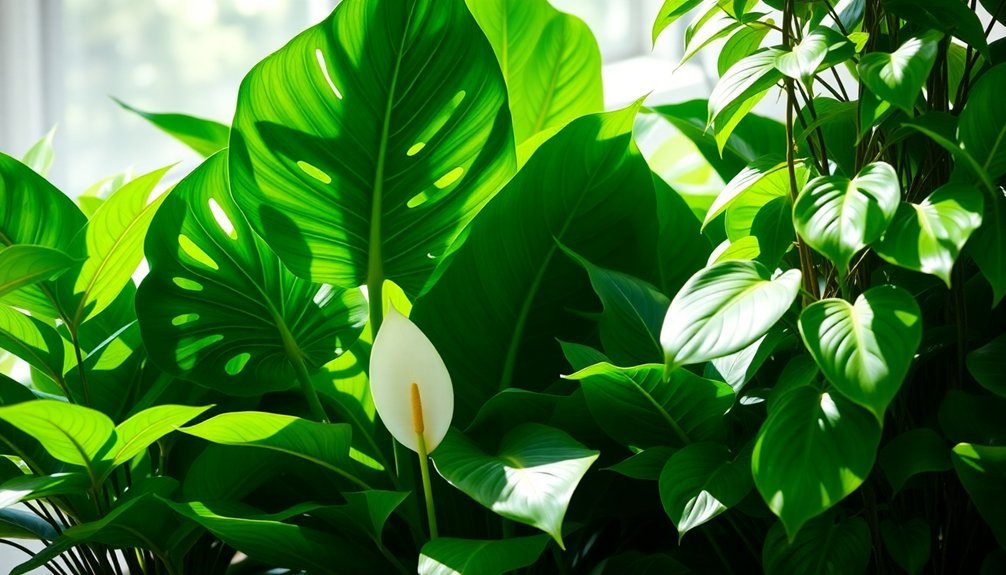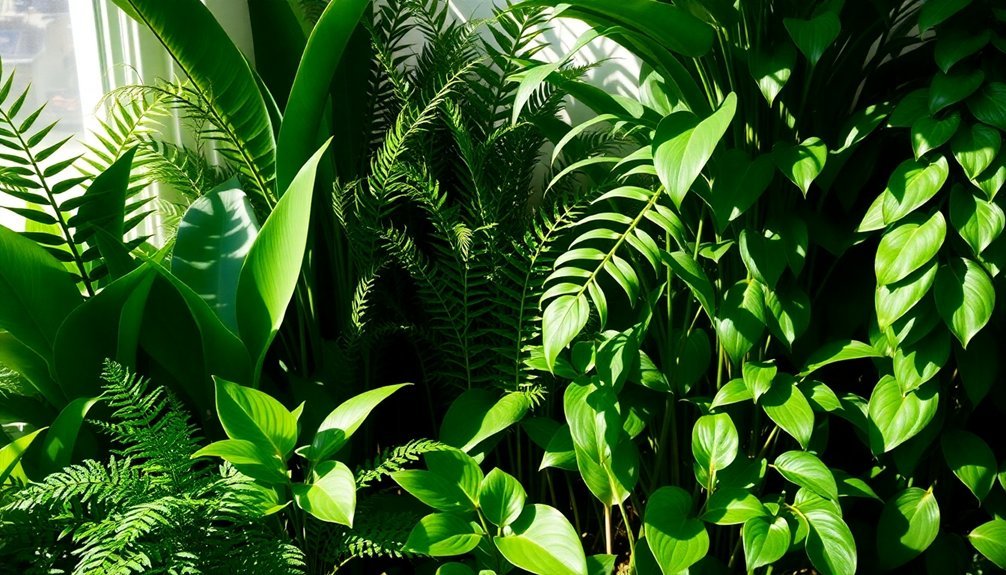Tropical plants provide exceptional year-round air filtration thanks to their broad leaves and adaptability to indoor environments. You'll get outstanding results with NASA-proven champions like Snake Plants, Peace Lilies, Spider Plants, ZZ Plants, Chinese Evergreens, Boston Ferns, and Rubber Plants. Place one plant per 100 square feet, focusing on areas with limited airflow or known pollution sources. Understanding the unique care needs and ideal placement of these powerful air purifiers will transform your indoor air quality.
Why Tropical Plants Excel at Year-Round Filtration

While many houseplants go dormant during winter months, tropical plants maintain their filtration powers throughout the year thanks to their unique adaptations.
You'll find that these resilient plants have evolved to thrive in warm, humid indoor environments, making them particularly effective at removing harmful pollutants like formaldehyde and benzene from your air.
Their broad leaves give tropical plants superior air-purifying qualities, as the increased surface area allows them to capture more airborne toxins.
NASA research confirms their exceptional filtration capabilities in reducing volatile organic compounds (VOCs).
Species like the Peace Lily and Rubber Plant are especially adept at creating healthier indoor spaces, as they've developed efficient mechanisms to process these harmful substances.
With proper care, you'll benefit from their consistent air-cleaning performance regardless of season.
Top Indoor Plants for Consistent Air Purification
You'll find exceptional year-round air filtration from NASA-proven champions like the Snake Plant, Peace Lily, and Spider Plant, which consistently remove common indoor pollutants including formaldehyde and benzene.
To maximize their air-cleaning potential, place these powerhouse plants strategically throughout your living spaces, focusing on areas with limited airflow or known pollution sources.
Consider combining low-maintenance options like ZZ Plants and Chinese Evergreens for darker areas with Boston Ferns in humid spaces to create a thorough indoor air purification system that works tirelessly all year.
Year-Round Air Cleaning Champions
Since maintaining clean indoor air is a year-round necessity, certain houseplants excel at providing continuous air purification without taking a seasonal break.
You'll find reliable performers like the Golden Pothos and Bamboo Palm working tirelessly to remove toxins while requiring minimal care. NASA's Clean Air Study confirms that champions such as the Snake Plant and Peace Lily effectively filter harmful substances like formaldehyde and benzene from your indoor air.
For ideal results, you'll want to place one air purifying plant per 100 square feet of space.
Consider adding low-maintenance options like the ZZ Plant or Rubber Tree, which beautify your space while consistently cleaning the air. The Spider Plant and Boston Fern are particularly effective choices, as they thrive indoors while continuously filtering pollutants throughout all seasons.
Essential Plant Placement Tips
Strategic placement of air-purifying plants can dramatically boost their effectiveness in cleaning your indoor air. To maximize their impact, you'll want to position one air-purifying houseplant per 100 square feet of space.
Create clusters of plants to enhance their collective filtering power against indoor pollutants.
When considering plant placement tips, utilize low-light tolerant varieties like Snake Plants and ZZ Plants in darker corners, where they'll still effectively remove toxins while thriving in indirect light.
Place moisture-loving plants such as Peace Lilies and Boston Ferns in naturally humid areas like bathrooms and kitchens.
Don't forget to rotate your plants periodically to guarantee even light exposure, maintaining their air-cleaning abilities throughout the year. This simple practice helps your green allies perform at their peak year-round.
Optimal Placement for Maximum Filtration Effect

While indoor plants naturally filter air, their placement plays a crucial role in maximizing their purifying potential. For best placement, you'll want to position air-purifying plants strategically throughout your home, following NASA's recommendation of one plant per 100 square feet.
To help your plants filter toxins effectively, place them near pollution sources like kitchens and living areas. South or east-facing windows provide perfect lighting conditions that enhance your plants' air-cleaning abilities.
You'll get even better results by clustering multiple plants together, as this creates a more concentrated filtration zone.
Don't forget to rotate your plants periodically to different spots in your home. This practice promotes balanced growth and maintains consistent air purification throughout your space year-round.
Maintaining Air-Filtering Plants Through Seasons
To keep your air-filtering plants performing their best throughout the year, you'll need to adapt your care routine to match the changing seasons. Guarantee proper lighting by adjusting plant placement as natural sunlight patterns change. Allow water to drain completely and monitor soil moisture, especially during winter when indoor heating can dry out plants faster.
| Season | Care Focus | Plant Needs |
|---|---|---|
| Spring | Pruning | Increased water |
| Summer | Growth monitoring | Regular trimming |
| Fall | Pest prevention | Light adjustment |
| Winter | Humidity control | Reduced watering |
| Year-round | Health checks | Consistent cleaning |
Maintain ideal humidity levels using a humidifier or by grouping plants together. Regular pruning improves air quality by removing dead leaves and encouraging healthy growth. Watch for pest infestations during seasonal changes when your plants are most vulnerable to environmental stress.
Combining Plants for Enhanced Year-Round Results

Building a diverse collection of air-filtering plants creates a more powerful defense against indoor pollutants than relying on a single species.
You'll maximize your air-purifying benefits by combining plants like Spider Plants, Peace Lilies, and Golden Pothos, which work together to filter different toxins from your air.
To create an effective natural air purifier, place one plant per 100 square feet, and group compatible species that share similar light requirements.
Try pairing ZZ Plants with Snake Plants in low-light areas, or Boston Ferns with Bamboo Palms to boost humidity levels.
You'll get the best results by strategically rotating your plant combinations throughout the year, as each species excels at filtering specific pollutants during different seasons.
This approach guarantees continuous air purification while maintaining an attractive indoor environment.
Signs Your Plants Are Actively Filtering Air
Your plants will show clear signs when they're actively filtering the air through their vibrant, healthy leaves and steady growth patterns.
You'll notice rich, deep green coloring in the foliage, which indicates robust photosynthesis and effective air purification taking place.
New leaf growth and strong stems are additional visual markers that your plants are thriving and actively removing indoor pollutants from your space.
Visual Growth Indicators
Nature provides clear signals when air-filtering plants are performing at their peak. You'll notice visual growth indicators such as larger leaf size and vibrant foliage in thriving air purifiers like Spider Plants and Peace Lilies. Your plants' effectiveness shows through consistent leaf coloration and reduced dust accumulation on their surfaces.
| Indicator | What It Means |
|---|---|
| New Growth | Active photosynthesis and filtering |
| Fresh Blooms | Healthy air purification cycle |
| Clean Leaves | Successful particle trapping |
Watch for the emergence of fresh leaves on your Rubber Plant and new blooms on your Anthurium – these signs confirm your plants are actively filtering indoor air. When leaves maintain their natural color without yellowing or browning, it's a reliable signal that your air-purifying plants are working effectively and receiving proper care.
Leaf Color Changes
Plant leaves act as natural barometers of their air-filtering performance. When you're monitoring leaf color in your houseplants, you'll notice that vibrant green foliage indicates they're actively filtering air pollutants.
Plants like Spider Plants showcase their air-purifying effectiveness through their healthy green hues as they process carbon dioxide and remove toxins.
Watch for leaf color changes that might signal decreased filtering ability. If your Peace Lily's leaves turn yellow, it's likely struggling with pollutants or needs better care to maintain its air-cleaning power.
The Chinese Evergreen's variegation patterns can reveal how well it's adapting to your home's air quality. By paying attention to these visual cues, you'll know when your plants are performing at their peak filtering capacity or when they need attention to restore their air-purifying abilities.
Seasonal Care Tips for Air-Purifying Plants

While many air-purifying plants adapt well to indoor environments, they still need seasonal adjustments to maintain peak filtering performance.
You'll want to reduce watering for Spider Plants and Peace Lilies during winter months when their growth naturally slows down.
During spring and summer, boost humidity levels for plants like Boston Ferns by misting them or using pebble trays to maximize their air-cleaning abilities.
To keep your air-purifying plants healthy year-round, rotate them regularly for even light exposure, especially Rubber Plants.
Keep sensitive varieties like Anthuriums away from drafts and heating vents during seasonal shifts.
You'll find that low-maintenance options like Snake Plants and ZZ Plants require minimal seasonal care tips, making them perfect choices for consistent air filtration throughout the year.
Frequently Asked Questions
What Plant Purifies the Air the Most?
You'll find Snake Plants (Sansevieria) lead in air purification, effectively removing toxins like formaldehyde and benzene. They're exceptional because they continue filtering air even at night while most plants rest.
What Plant Removes 78% of Airborne Mold?
The Boston Fern removes 78% of airborne mold spores from your indoor air. You'll find it's most effective when you place it in humid areas like bathrooms, and don't forget to mist it regularly.
What Plant Is NASA Recommend for Air Purifiers?
NASA recommends Spider Plants, Peace Lilies, and Snake Plants for air purification. You'll find these plants effectively remove common toxins like formaldehyde and benzene. They're easy to maintain and work year-round.
What Are the Best Filtering Plants?
You'll find the best filtering plants are spider plants, peace lilies, bamboo palms, and snake plants (mother-in-law's tongue). They'll effectively remove harmful toxins like formaldehyde, benzene, and xylene from your indoor air.
In Summary
You'll find that investing in these seven air-purifying plants transforms your indoor air quality throughout the year. Place them strategically, maintain them properly, and watch for signs they're working effectively. By combining different species and following seasonal care guidelines, you're creating a natural filtration system that works 24/7. Don't forget to rotate your plants occasionally to maximize their air-cleaning potential.





Leave a Reply